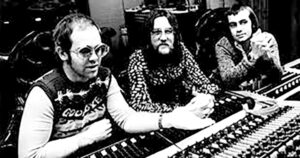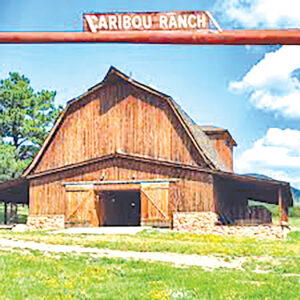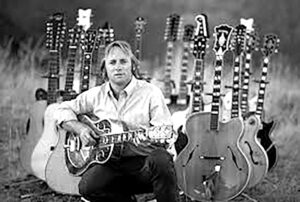 By Nick Wills
By Nick Wills NEDERLAND, Colo. (KDVR) – A property that sits 30 minutes west of Boulder was at varying instances the home of the country’s largest privately owned Arabian horse stud farm, a motion picture set and the refurbished barn that from 1974 to 1976 produced more musical hits than Abbey Road.
That property, which according to the Colorado Music Hall of Fame arguably outperformed the British recording studio for a few years, is known as the Caribou Ranch.
According to the Colorado Encyclopedia, it was purchased in 1971 and molded by a Columbia Records employee who had grown tired of the industry’s production habits that held efficiency above creativity.
That music producer’s name was James William Guercio, and according to the Colorado Music Hall of Fame, he bought roughly 4,000 acres outside of Caribou near Nederland with a plan in mind to create a one-of-a-kind recording studio that aimed to cater to the creative side of musical production.
 The man who merged record producing and the Rocky Mountains
The man who merged record producing and the Rocky Mountains According to the Colorado Encyclopedia, Guercio would go on to help produce albums that accrued more than $100 million in record sales, 18 Grammys, 20 No. 1 Billboard hits and 45 top 10 albums through focusing on the creative aspect of musical production.
The Colorado Music Hall of Fame said that while producing in Los Angeles and New York, Guercio had found his creative efforts constrained by the record label’s union regulations. One rule that he found specifically bothersome, according to the Colorado Encyclopedia, said that a sound engineer employed by the studio was in charge of running the controls during recordings, which could stand in the way of what the artists and their producers were aiming to achieve.
So, with the property purchased and the barn under renovation, Guercio would soon find out if his revamped approach to music production was going to catch fire The guest ranch wouldn’t even be up and running before he’d find the answer to that all-important question.
One man’s blown-out mixer is another man’s good fortune
According to the Colorado Music Hall of Fame, just three years before he would join the Eagles, Joe Walsh was starting production on his inaugural album, an effort he was attempting to manage out of his home.
Fortunately for Guercio and the future of his Caribou Ranch recording studio, Walsh’s in-house mixer blew out leaving him to figure out where to move his recording efforts.
The Caribou Ranch was still being built, but when Walsh heard about the recording studio under development, he wanted to check it out along with his producer at the time, Bill Szymczyk. According to the CMHOF, once the pair arrived at the Caribou Ranch, the two knew that the ranch would be the perfect fit for the project.
 “My answer is serendipity,” Szymczyk said according to Best Classic Bands. “It was a case of once two or three people came, other people heard there was something going on. When [Guercio] built the studio – game over.”
“My answer is serendipity,” Szymczyk said according to Best Classic Bands. “It was a case of once two or three people came, other people heard there was something going on. When [Guercio] built the studio – game over.” After Walsh completed “Barnstorm,” the first album recorded at the Caribou Ranch, Szymczyk would bring another of his performers to the Nederland-adjacent studio, Rick Derringer, who would record his hit “Rock & Roll, Hoochie Koo.”
Elton John would soon hear the unique tonal qualities of the Caribou Ranch studio present in Derringer’s work, which sound engineer and physicist Tommy Dowd said was the result of the thin air, and decided to visit the property after a Denver show. The property sits at an elevation of 8,600 feet and that, mixed with the analog equipment used at the recording studio, was creating a detectable sound, according to the Colorado Encyclopedia.
“It really is luxurious,” John said according to Colorado Music Experience. “The only thing you can’t get used to is that it’s so high up, you keep gasping for breath all the time.”
John would name the first album he recorded in the barn after the ranch, entitling it “Caribou.” He would go on to record his following two albums at the ranch, setting off the wave of legendary performers that would come in and out of the barn doors.
According to the Caribou Ranch’s homepage, Stevie Wonder, Stevie Nicks, John Lennon, Chicago, Carole King, the Beach Boys, Rod Stewart, America, Kris Kristofferson, Earth, Wind & Fire, Jerry Lee Lewis, Sheena Easton, Eddie Rabbit and War make up just a portion of the pool of legendary artists who visited the recording studio at Caribou Ranch during its nearly 15-year existence.
“You’re kinda immersed into the wild, wild west,” Earth, Wind & Fire’s Philip Bailey said, according to Best Classic Bands. “The quiet, the music of the mountains became so obvious, so loud, that you kinda got caught up in that whole experience. I remember me and Maurice [White] writing the lyrics to ‘Sing a Song.’ We’re singing the same thing at the same time, getting the same ideas at the same time. It really was a magical time.”
 Artists didn’t visit the ranch in order to produce music exclusively. The property, which Michael Jackson reportedly tried to buy off of Guercio when the King of Pop visited after his Thriller tour wrapped up, was also a retreat for artists who wanted to “escape the hustle and bustle of their paparazzi-filled lives,” according to the Caribou Ranch artists page.
Artists didn’t visit the ranch in order to produce music exclusively. The property, which Michael Jackson reportedly tried to buy off of Guercio when the King of Pop visited after his Thriller tour wrapped up, was also a retreat for artists who wanted to “escape the hustle and bustle of their paparazzi-filled lives,” according to the Caribou Ranch artists page. During an interview on Jimmy Kimmel Live, Elton John revealed that he let Stevie Wonder, the musical legend who has been blind since birth, take his snowmobile out for a drive during some downtime at the ranch.
“I was at the Caribou Ranch…I was recording…It was thick snow and Stevie wanted to go out on the snowmobile…(He went out) by himself…We thought, ‘OK, that’s another rival gone! That’s him out of the way.’ Just needed to get Phil Collins and Rod Stewart up there,” John said to Kimmel.
In all over 150 artists came through the valley outside of Nederland to get away, partaking in hiking through Colorado’s backcountry, horseback riding the nearby trails, wildlife gazing and more.
How this musical haven came to an end
Unfortunately for Guercio and the generations of artists who never got to visit the studio, the studio came to an end in March of 1985 while he watch television with his family nearby. According to the Colorado Encyclopedia, a space heater ignited a blaze that took out a third of the barn that housed the legendary studio. Guercio decided to not repair and rebuild as the music industry had moved on, leaving behind the analog recording practices of old and instead transitioning to digital recording equipment. Another reason for choosing not to replace the lost studio was that the scene surrounding rock-and-roll in the 1980s was not one to raise children around.
There were once talks of the ranch being redeveloped, but those never came to fruition. Now, the Caribou Ranch is just a property where musical memories remain and a location that can be heard in a list of albums that were created with the help of 8,600 feet of elevation, and a music producer who knew the importance of creativity in an artist’s creative journey.















Follow Us